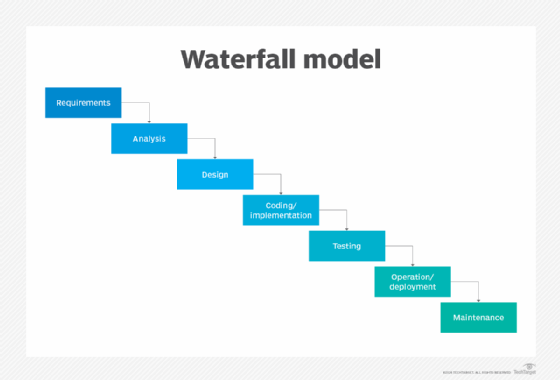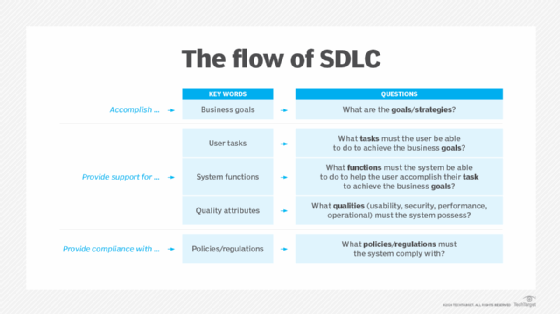What is systems development life cycle?
The systems development life cycle (SDLC) is a conceptual model used in project management that describes the stages involved in an information system development project -- from an initial feasibility study all the way through maintenance of the completed application. SDLC can apply to both technical and nontechnical systems. In most cases, a system describes an IT technology such as hardware and software. Project and program managers, system and software engineers, development teams and end users all take part in the SDLC.
What is the systems development life cycle in project management?
Every hardware or software system goes through an iterative development process with multiple steps, with each phase encompassing a certain set of activities and tasks.
The SDLC creates a systematic structure and reusable framework to define the various steps involved in the development of a system. It provides a measurable and repeatable development process, clarifies the scope of activities and helps project managers to assign appropriate roles and responsibilities to the resources and parties involved in the project.
Complex projects particularly benefit from the SDLC approach. For such projects, the development process can be time-consuming, complicated, prone to numerous roadblocks and involve numerous parties. The SDLC provides project managers with the tools to identify and mitigate such roadblocks and minimize complexity as the project progresses.
Ultimately, by adopting the SDLC methodologies and tools, teams and project managers can deliver high-quality systems on time and within budget, while minimizing project risk, maximizing accountability and increasing the probability of project success.
Systems development life cycle vs. software development lifecycle
In the context of the SDLC, a system usually refers to an IT technology -- but includes both hardware and software. Unlike the software development lifecycle, which is mainly concerned with software development projects, the systems development life cycle has a broader and wider scope. It not only incorporates development activities, but is also concerned with activities related to people, processes, networks and data. Additionally, it is concerned with activities such as the following:
- System analysis.
- Feasibility studies.
- System planning, deployment and operations.
- System maintenance.
- Infrastructure planning and management.
- Change management.
- System disposal.
For many projects, the systems development life cycle includes the narrower software development lifecycle. In other words, the systems development life cycle is a superset of the software development lifecycle.
Project and program managers typically take part in the systems development life cycle, along with the following:
- System engineers.
- Software engineers.
- Development teams.
- DevOps engineers.
- Designers.
- Testers.
- Maintenance teams.
In some projects, end users might also be involved in the SDLC. Their responsibilities can include the following:
- Sign off on the requirements.
- Provide feedback following a canary (limited) release.
- Provide feedback following the full release.
SDLC models
Over the years, various SDLC methodologies have been developed, including the original SDLC method, the Waterfall model.

Other popular SDLC models include the following:
- Rapid application development (RAD).
- Joint application development (JAD).
- Fountain model.
- Spiral model.
- Build and fix.
- Synchronize-and-stabilize.

In recent years, the Agile software development model has also become very popular. This model prioritizes collaboration and communication among project team members, which enables them to stay aligned regarding project expectations and requirements. It also enables teams to consider and implement changes based on regular feedback without seriously impacting the project's schedule, scope or budget. In addition, this model accounts for shifting project requirements, which might not always be apparent at the start of the SDLC but emerge as it progresses.
Several models can be combined into a hybrid methodology. The models chosen depend on the project type, scope, requirements, characteristics, vision and other factors. Some methods work better for specific kinds of projects, but in the final analysis, the most crucial factor for the success of a project is often how closely the plan is followed. Regardless of the model chosen, documentation is crucial in the SDLC, usually done in parallel with the development process.
What are the 7 phases of SDLC?
The SDLC consists of multiple phases, with different specialists involved in each. Many phases are interdisciplinary and include personnel from different specialties working together to move the project to the next phase and toward completion.
In general, every SDLC consists of these seven phases:
- Analysis. The organization evaluates the existing system, identifying deficiencies. This is often done by interviewing users and consulting with support personnel. Management determines whether they require a new IT system to solve a particular problem or address a particular need.
- Requirements gathering, planning and analysis. Once the new system requirements are defined based on an analysis of the pain points the system means to target, the project manager might then create proposals for addressing the deficiencies in the existing system, outline the development process and set project deadlines and milestones. They will also define other factors required in the new system including features, functions and capabilities.
- Design. The project team designs the proposed system. The team should consider factors such as physical construction, hardware, operating systems, programming, databases, communications, user interfaces and security. The organization might develop a prototype to show stakeholders what the final product could look like.
- Development. The project team develops the new system based on the requirements and design that were finalized in the earlier stages. Developers write code using the appropriate programming environment and language. The team obtains and installs new components and programs.
- Testing. System tests confirm that the system's features work correctly and that it satisfies user expectations. If necessary, the project team makes adjustments to address issues such as bugs, defects, security gaps or other exploitable vulnerabilities. Tests performed by quality assurance (QA) teams can include systems integration, user acceptance testing (UAT) and system testing.
- Integration and deployment. The new system is incorporated in a production environment and integrated with other systems as required. Deployment can happen in several ways: The new system can be phased in according to application or location, and the old system gradually replaced in a phase-wise manner; however, in some cases, it can be more cost-effective to completely shut down the old system and implement the new system all at once. Users are then trained for the new system.
- Upkeep and maintenance. This step involves changing and updating the system once in place. An organization upgrades or replaces hardware or software to continuously meet the requirements of end users. Users should be kept up to date concerning any modifications to minimize confusion or productivity losses.
Other steps that often appear in the SDLC include project initiation, functional specifications, detailed specifications, evaluation and end-of-life planning. The number of steps involved in any given SDLC vary depending on the project size, timeline or complexity.
Typically, the more steps defined in an SDLC model, the more granular the stages are. For complex or high-visibility projects, it can be useful to define granular stages -- these can provide early clarity on requirements and expectations and minimize the potential for conflict, confusion or rework.

Advantages of the SDLC
The SDLC provides a reusable and clear framework to easily manage and implement systems development projects. Its benefits include the following:
- Providing a clear view of an entire project -- including resources, estimated costs and timelines -- to everyone involved in the project.
- Enabling project managers to calculate the project base cost and assign a reasonable budget.
- Clearly defining goals and standards to which the team must adhere to ensure project success.
- Providing developers with the tools to make changes if something unexpected occurs without majorly impacting the project's cost or delivery timelines.
- Enabling management to retain control over large or complex projects.
- Improving collaboration and communication within a project team, resulting in better teamwork and risk management.
- Improving accountability, transparency and traceability; accelerating problem-solving; and minimizing conflicts.
Challenges with the SDLC
Project managers and teams should also be aware of the challenges they might face during the SDLC. Unexpected circumstances and incorrect assumptions early on can complicate development and even snowball into greater complications later. For example, if newly installed hardware does not work correctly, it might require redevelopment, which not only delays the final delivery, but also increases system cost.
Another challenge is that some SDLC methods are not flexible. For example, the V-model -- verification and validation -- requires a well-defined timeline and clear requirements, which leaves little room for accidental delays. Certain models -- such as Agile -- work better than others for projects with unclear requirements.
Cost estimations are often particularly difficult for complex projects. Even so, some estimate is usually better than no estimate at all, because it helps with the planning of other aspects of the project, including scope and resources.
Finally, testing at the end of the development phase can slow down development teams. One way to overcome this challenge is to conduct testing and development in parallel. This approach, known as shift-left testing, provides dev teams with continuous feedback that they can incorporate during the development phase. This ultimately results in a better quality system for implementation and deployment and minimizes the requirement for costly or time-consuming rework later.
See how to make the shift-left testing approach work for your team and explore how experts run shift-left and shift-right testing. Because project, program and portfolio management are related but represent distinct disciplines, you should know the responsibilities and goals of each as well as how they differ. Also, see how AI is transforming project management.






